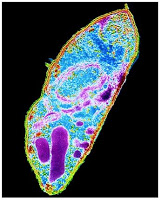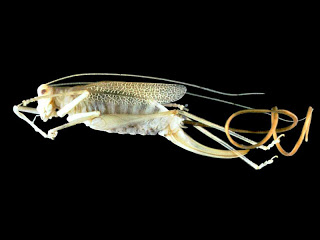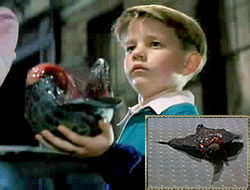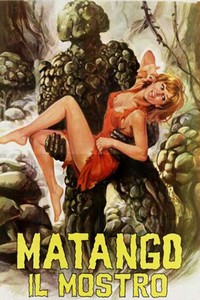 Zombies are almost always blamed on viruses.
Zombies are almost always blamed on viruses.
In movies, books and comics, if an explanation is given, it’s usually a virus.
Or radiation—that stuff is just like magic in movies, it can make animals grow, grant super powers and do incredible thing.
In nature, no virus has made a zombie that we know of—a hybrid of the Flu and Rabies would create a virulent Zombie virus.
However, there are zombies in nature after a sense.
Zombification is a strategy taken up by many parasitic organisms to fulfill their life cycles and breeding habits. They take over the brains and bodies of their hosts and force them to act against their will and/or infect others.
There are 4 groups of organisms create zombies for various reasons. These include worms (round and flat), protozoa, parasitoid wasps and fungi.
The Parasitic worms have the oddest effects.
These worms change the behaviors of higher organisms and generally work to get them eaten. There are two flatworm species that do this and one roundworm.
The flatworm Leucochloridium paradoxum attacks Gastropods.
They warp their bodies around the brain, force themselves up the antennae—where they become neon signs for birds, screaming “Eat me!”. The Worms control the mind of the snails they infest in a simple way. They change their desire to hide underneath leaves and on the ground to climbing up plants and resting in the daylight sun where they can best advertise their neon signs.
A similar behavior is found in the proazoa, Toxoplasma gondii, does the same to rats: making them like light and be attracted to the smell of cats (well, their urine at least)—things that they would normally avoid at all costs. These worms want to get back into the predators of these animals (and the later species ends up in humans and can causes schizophrenia). Not quite Romero’s shamblers, but a step in that direction for certain.
The Roundworm species, Spinochordodes tellinii, is a parasitic nematode similarly alters the behavior of crickets and grasshoppers.
Like the other worms, it only alters the behavior of its organisms slightly. It’s eaten by grasshoppers and such as microscopic larva and grows to adulthood without the host being well aware of it. It’s a proper parasite, keeping the host alive for most of its life. Until it is time to breed. These nematodes breed in water and once an adult senses a large body of water, the mind control kicks in and it makes the host rush towards it and jump right in, so the worm can escape and breed, leaving the host to drown.
It was originally thought that parasites could only really control the host if the organism had greater intelligence than the host. It turned out to not be the case and the behaviors were only the result of a few subtle tweaks in the brain—something even a simple organism could do.
In fiction, Heinlein’s The Puppet Masters and Stargate SG-1’s Goa’uld are far more worm-like symbiotic organisms. As alien beings, they would not be true worms, gastropods or anything within earthly biota. With human-like intelligences which take over the minds off their hosts almost completely in the Goa’uld’s case or altering their perceptions as in Heinlein’s story.
In both cases, the parasitic take over is almost instantaneous, which is something that works only towards plot convenience. Actual parasitic control takes time to assert itself—hours or days at best, depending on the size difference in the organisms. With Spinochordodes, the worm, while very thin, is several times longer than the host when stretched out in its adult size.
So, how would worm zombies work?
Well, they wouldn’t, really.
At least, it wouldn’t behave in a way we’re familiar with as zombies. Ruling out the species that are trying to get back to predators, we can modify Spinochordodes behavior and have a society of humans who, if they are infected, have a 10 foot long, 2 inch thick worm around their spines who drown themselves in deep water. They wouldn’t be zombies as such, but it would make an interesting post-apocalyptic society to stumble across.
But what would it need to tweak to make a zombie?
It’d have to remove our ability to sense pain, for one. Second, it would need to give us a reason to kill or eat other people. The most common reason given in movies for Zombies to bite is to ‘spread the love,’ which for a worm is pretty darn hard. Biting is not the best method of transferring something like worm eggs. Like the worms in nature, a passive method of spreading the eggs would better ensure the survival of the breeding animal and the offspring.
Of course, that assumes the worms would reproduce asexually, which some do, but most don’t. Sexual reproduction just adds another layer to prevent the worm from creating a true Romero Shambler.
In short, worms are the worst option for making zombies of the multicellular organisms available.
What about Fungi? The parasitoid fungi of the genus Cordyceps and Ophiocordyceps are great zombie maker candidates, but like the worm types, they would not try to kill other people actively. They wouldn’t throttle them like The Crazies, nor would they seek to bite, spew vomit upon or consume the brains of other humans.
Mostly because they wouldn’t have to. Their method of infection and spreading is far more efficient and hundreds of times deadlier.
Let’s let David Attenborough explain how these Fungi behave:
Now, imagine that behavior transplanted to humans. In a major city.
Fungus-based “zombie” have appeared only a few times in fiction, the most well-known of which as to be their appearance in the Halo series.
These creatures are called The Flood and are responsible for the destruction of a galactic civilization (or more than one). The virulence is highly exaggerated (as media often does) and the organism is given two methods of infecting a host: a living body infected with a foot-long infection form; and their spores to infect the dead. All in all, not the best use of a true fungus-based zombie.
An older example could be found in the film Matango, (dubbed in the US as Attack of the Mushroom People, seriously) a Japanese sci-fi thriller where the titular mushrooms, when consumed, infected the host and turned them into, effectively, mushroom people.
This transformation is slow and degenerates the mind, making the human want to eat more off the mushrooms (which, if you know your fungi, is just the fruiting part of the organism) and help spread the fungus once it takes full control.
This allows the fungus to escape its little radioactive island and reach the mainland. The rapid-spreading fungi and viruses of modern movies, books and games ignore the beauty of stealth infiltration.
Why the spores need to be ingested to become a true Mushroom person instead of just making more mushrooms is a reasonable question that’s never explained, but the ability to spread farther than where the wind blows is a definite advantage for any fungus.
A final film example can be seen in the 2008 independent horror film Splinter. Aside from the rapid growth from infection to bloom, it gives a good alternative method for a fungal zombie to grow. The titular splinters are the fruiting part of the fungus, which are used to infect other organisms.
This unique method of reproduction grants the fungus a legitimate reason to animate its host and cause them to attack others. Their heat-vision, however, is a bit odder overall, given the virulence of their infection.
Still, it’s easier to comprehend visually than hunting by smell.
So far, for a non-virus Zombie, Fungi are our best bet. But what about the Wasps?
You’re going to have to wait for Part 2 for them!

















































































































